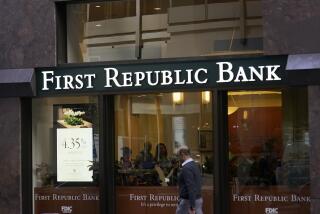FDIC warns of more failures
- Share via
WASHINGTON — Federal regulators Tuesday boosted to $8.9 billion the estimated cost of IndyMac Bank’s failure and prepared the public for more collapses, reporting that the number of troubled U.S. banks shot up 30% in just three months.
The Federal Deposit Insurance Corp. said that on June 30 there were 117 institutions on its “problem list,” up from 90 on March 31 and the highest level in five years.
The disclosures were part of a bleak portrait of the banking industry painted by the agency, which said earnings at commercial banks and savings and loans plunged 87% to $5 billion in the second quarter as institutions scrambled to cover bad mortgages and other loans.
“Quite frankly, the results were pretty dismal,” FDIC Chairwoman Sheila C. Bair said at a news conference. Aside from the fourth quarter of 2007, bank earnings were at their lowest since 1991.
Historically, about 13% of banks on the problem list fail. But Bair predicted the list would grow.
“We don’t think this credit cycle’s bottomed out yet,” she said.
This year nine banks with total assets of $40 billion have failed, according to the FDIC.
Although the banking industry is clearly under stress, the size of the list shouldn’t be alarming, said Michael M. Heller, president of Veribanc Inc., an independent bank rating firm in Woonsocket, R.I.
Even in 2005 and 2006, years when no banks failed, there were 40 to 50 institutions on the FDIC’s problem list, Heller said.
“Are we in a tough time for the industry?” he said. “Yes, absolutely. But is it panic time like in the late ‘80s and early ‘90s? No way.”
At the end of 1992, toward the end of the savings and loan crisis, 1,063 institutions were on the list.
The agency doesn’t release the names of troubled institutions for fear of inciting a rush by depositors to withdraw their money.
The FDIC’s revision of the cost of the IndyMac failure raises questions about the agency’s ability to estimate the cost of future failures.
The FDIC originally estimated the collapse of IndyMac, which had $32 billion in assets, would cost the deposit insurance fund $4 billion to $8 billion.
That figure increased after the agency, which now runs the bank, performed its own valuation of IndyMac’s assets and also discovered that more deposits than initially estimated were covered by insurance, said Diane Ellis, the FDIC’s associate director of financial-risk management.
Reflecting those troubles, the FDIC is adding staff and working on a plan to replenish the deposit insurance fund, which covers the accounts of most bank depositors.
Largely because of the IndyMac failure last month, the deposit insurance fund has dropped below its mandated level.
On June 30 the fund equaled 1.01% of insured deposits, the lowest level since 1995 and down from 1.19% on March 31. Under federal law, when the fund drops below 1.15% the FDIC must raise the insurance premiums banks pay into the fund to push its balance back above the required level within five years.
Bair said the FDIC board would consider in October a proposal to raise the premiums, which currently range from 5 cents to 43 cents per $100 of deposits, depending on how well capitalized the institution is.
--
scott.reckard@latimes.com
More to Read
Inside the business of entertainment
The Wide Shot brings you news, analysis and insights on everything from streaming wars to production — and what it all means for the future.
You may occasionally receive promotional content from the Los Angeles Times.











